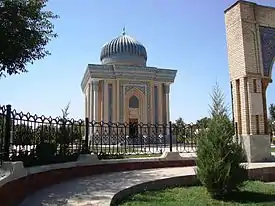Syed Ahmad Barelvi
Syed Ahmad Barelvi or Sayyid Ahmad Shaheed (1786–1831)[1][2] was an Indian Hanafi Maturidi Muslim revivalist from Raebareli, a part of the historical United Provinces of Agra and Oudh (now called Uttar Pradesh).[3] The epithet Barelvi is derived from Rae Bareilly, his place of origin.
Syed Ahmad Shaheed | |
|---|---|
 Grave of Syed Ahmad Shaheed in 2014 | |
| Personal | |
| Born | 29 November 1786 |
| Died | 6 May 1831 (aged 44) |
| Religion | Islam |
| Known for | Battle of Balakot |
| Muslim leader | |
Influenced by
| |
Early Life and Militia Service
Born in Rae Bareli in 1786, Syed Ahmad received his initial education at his home town and went to Lucknow at the age of 18 in search of a job but failed. He then moved to Delhi where he became a disciple of Shah Abdul Aziz. He resided there from 1806 to 1811, then at the age of 25 he joined militia of Amir Khan, a military expeditionary. This was the era of military campaigns in India during which nawabs and governors established their power by occupying territories. Syed Ahmad spent seven years in the service of Amir Khan, who only fought to loot and plunder. In 1817, after the Third Anglo-Maratha War, Amir Khan allied with the East India Company, the Governor-General and Commander-in-Chief, The Marquess of Hastings, resolved to defeat the Pindaris whom they deemed a menace. The Treaty of Gwalior severed the link between them and Scindia. Moreover, the treaty required the latter to join forces with the East India Company to eliminate the Pindaris and Pathans. Bowing to the inevitable, Amir Khan assiduously came to terms with the British, agreeing to disband his men in return for a large stipend and recognition as a hereditary ruler. Amir Khan was recognized as hereditary nawab, disbanded his forces and quietly settled down to consolidating his little state. He became a faithful friend to the British, earning praise and consideration from successive pro-consuls. From Sayyid Ahmad's perspective, this was a strategic disaster, because for him the British were Christian heretics.[4] Syed Ahmad was unemployed again with 30,000 other soldiers. Syed Ahmad came to Delhi after the end of his service and from here he decided to become a power player like Amir Khan. Barbara Metcalf theorizes this period in Sayyid Ahmad's life as a time of maturation, when he began to synthesize his experience in state-making and his commitment to the Sharia.[5] He was joined by two members of the Shah Waliullah family: Shah Ismail Dehlavi (1771-1831) and Maulvi Abdul Hai (died 1828).[6] This endorsement only added to Syed Ahmad's reputation, and his popularity grew with adherents flocking to him by the thousands.[7]
Reform Movement
According to Olivier Roy, Barelvi was "the first person to realize the necessity of a movement which was at the same time religious, military and political." He also was the first to address the people, not traditional leaders in his call for jihad. His evangelism—based on networks of preachers, collectors and judges—also addressed the common people and not the rulers' courts.[8] The reform movement started with the idea of wahabist understanding of monotheism, and the fight against the local interpretations and customs that, according to him, had corrupted Islam. Barbara Metcalf writes:
"Sayyid Ahmad's reformist teachings were set down in two works that, when printed on the new lithographic press of the day, soon achieved wide circulation. The Sirat'ul Mustaqim (the Straight Path) was compiled by Muhammad Ismail in 1819. Written initially in Persian, it was translated into Urdu in order to reach a wider audience. The second work, Taqwiyatul-Iman or the strengthening of the Faith, was written directly in Urdu. The two works stressed above all the centrality of tawhid, the transcendent unity of God, and denounced all those practices and beliefs that were held in any way to compromise that most fundamental of Islamic tenets. God alone was held to be omniscient and omnipotent. He alone, entitled to worship and homage. There were, the followers of Sayyid Ahmad argued, three sources of threat to this belief: false sufism, Shiá doctrines and practices, and popular custom".[9]
According to Andreas Rieck, Syed Ahmad visited towns of North Indian planes from 1818 to 1821 with hundreds of missionaries to preach against Shia beliefs and practices. Syed Ahmad repeatedly destroyed ta'ziyas, an act that resulted in subsequent riots and chaos.[10] Barbara Metcalf offers the following explanation to his anti-shi'ism:
"A second group of Abuses Syed Ahmad held were those that originated from Shi’i influence. He particularly urged Muslims to give up the keeping of ta’ziyahs. The replicas of the tombs of the martyrs of Karbala taken in procession during the mourning ceremony of Muharram. Muhammad Isma’il wrote,
‘a true believer should regard the breaking a tazia by force to be as virtuous an action as destroying idols. If he cannot break them himself, let him order others to do so. If this even be out of his power, let him at least detest and abhor them with his whole heart and soul’.
Sayyid Ahmad himself is said, no doubt with considerable exaggeration, to have torn down thousands of imambaras, the building that house the taziyahs".[11]
In 1821, Syed Ahmad left for Hajj along with a group of devotees. He returned from Haj in 1823,[8] and once again visited different parts of India. For Syed Ahmad and the followers of the Faraizi movement, India was "Darul Harb" the capital of war and therefore jihad was obligatory for the Muslims. In his book, Sirat-e-Mustaqeem, Shah Ismail Dehlavi wrote:
"a large part of present-day India has become “Dar-ul-Harab”. Compare the situation with the heavenly blessings of India two and three hundred years ago".[6]
Comparing India with Darul Islam, he said:
"compare India with Rome and Turkey in terms of heavenly blessings".[6]
Jihad and Islamic State
His target was the Sikh-ruled kingdom of Ranjit Singh, which was expanding further into Afghanistan. Barelvi intended to establish an Islamic bastion on the north-west frontier in the Peshawar valley from where he would attack the East India Company after defeating Sikh forces.[8]
When the action began, some Muslim nawabs, like his former employer Amir Khan, provided funds but did not join him for jihad. Around 8,000 holy-warriors who accompanied him were mostly clergymen or poor people who joined the militia were looking for employment. The rulers of Tonk, Gwalior and Rampur supported him with British consent because they were dependent on British forces and they knew well enough that the British would not stop them from aiding an enemy of a nation they would soon be at war with. Since Syed Ahmad’s campaign was based on Islamic concept of jihad, his spokesman, Shah Ismail Dehlavi, tries to create desire for the war by saying:
"as far as the special (sexual) benefits are concerned that go to the faithful Martyrs, the Muslim Mujahideen, the ruling Sultans and the brave men of the battle field, don't need to be elaborated here".[6]
Arriving in Peshawar valley in late 1826, Sayyid Ahmad and his followers made their base in towns of Hund and Zaida in Swabi District[12] Barelvi preached jihad amongst the local Pashtun tribes, demanding they renounce their tribal customs and adopt the Shariah. The traditional khan were replaced by ulama (clerics) and a system of Islamic taxes was established to finance the jihad. Only after this evangelist campaign and sharia system was had set up was jihad declared.[8] He sent a message to Ranjit Singh to
"either become a Muslim, pay Jizyah or fight and remember that in case of war, Yaghistan supports the Indians".[6]
The mujahideen received both ideological preaching and physical training sessions. Syed Ahmad organized wrestling, archery training and shooting competitions. The mujahideen also sang anthems. One such anthems has survived, known as "Risala Jihad", it goes as follows:
"War against the Infidel is incumbent on all Musalmans;
make provisions for all things.
He who from his heart gives one farthing to the cause,
shall hereafter receive seven hundred fold from God.
He who shall equip a warrior in this cause of God,
shall hereafter obtain a martyr's reward;
His children dread not the trouble of the grave,
nor the last trump, not the Day of Judgement.
Cease to be crowds; join the divine leader, and smite the Infidel.
I give thanks to God that a great leader has been born,
in the thirteenth of the Hijra".[13]
In December 1826 Sayyid Ahmad and his followers clashed with Sikh troops at Akora with some success. On 11 January 1827, allegiance was sworn on his hand and he was declared Caliph and Imam. Syed Ahmad’s claim of leadership (Caliphate) was viewed with suspicion in the Frontier region as well as in the clerical circles of North India. When the Friday sermon was read in his name, it became clear to the tribal chiefs that he wanted the political power for himself. According to Khadi Khan, a Pathan sardar:
"it is the job of the Sardars to take care of the people, not a Maulvi who spends his life on donations. Maulvies are ill-equipped to run the affairs of a State”.[6]
Syed Ahmad tried to explain that his aim was not this-worldly but to lead jihad against the infidels. In one of his letters, he writes:
"We thank and praise God, the real master and the true king, who bestowed upon his humble, recluse and helpless servant the title of Caliphate, first through occult gestures and revelations, in which there is no room for doubt, and then by guiding the hearts of the believers towards me. This way God appointed me as the Imam (leader)".[6]
Criticizing his opponents, Shah Ismail Dehlavi wrote:
"therefore, obedience to Syed Ahmad is obligatory on all Muslims. Whoever does not accept the leadership of His Excellency or rejects it after accepting it, is an apostate and mischievous, and killing him is part of the jihad as is the killing of the disbelievers. Therefore, the appropriate response to opponents is that of the sword and not the pen".[6]
Regarding his Imamate, Syed Ahmad wrote to Nawab Wazir ud-Dawla, the ruler of Tonk:
“believe me, the person who sincerely confesses to my position is special in the eyes of God, and the one who denies it is, of course sinful. My opponents who deny me of this position will be humiliated and disgraced”.[6]
Mubarak Ali writes:
"After the conquest of Peshawar, Syed Ahmad launched a violent policy to enforce Shari’ah and announced the abolition of all tribal rituals that he considered illegal. The most important of these rituals were: the bride was paid a regular price for marriage, the wives of the deceased were divided among his heirs, more than four marriages were practiced, women could not inherit property, internecine wars were considered jihad and plunder was considered booty. Therefore, after the conquest of Peshawar, orders were issued that those who can give half of the agreed money to the brides can take them. The young girls (9 year old and above) who are eligible for marriage should be married immediately. To enforce Shari’ah law, he appointed Imam Qutbuddin as an ombudsman, accompanied by 30 armed soldiers, who accompanied him to nearby villages to beat up the people who had abandoned prayers. Beatings and flogging had become the norm, that if the ombudsman went to any village, panic would spread. Punishment was carried out with extreme violence and people were even hanged on tree branches. Even among women, those who missed prayers were punished in the women’s quarters, so people soon became fed up with these policies because these judges and ombudsmen started harassing people and imposed fines on them beyond their means".[6]
In addition to the stated social agenda, Sayyid Ahmad also attempted to collect the Islamic tithe (usher) of ten per cent of crop yields. The alliance was defeated and the Islamic reformers finally occupied Peshawar. Over several months during 1830 Sayyed Ahmad tried to conciliate established power hierarchies. But before the end of 1830 an organized uprising occurred and the agents of Sayyid Ahmad in Peshawar and in the villages of the plain were murdered and the movement retreated to hills. There in the town of Balakot in 1831, Syed Ahmad was killed by the Sikh Army. He was beheaded.[12][14]

Battle of Balakot

Syed Ahmad's political and religious power created strong opposition against him in the Frontier region and the locals started to revolt.[8] The decisive moments for Sayyid Ahmad came in 1830. The Pukhtuns rose against him and his around two hundred Mujahidin were killed in Peshawar valley which compelled him to migrate and try his luck in Kashmir, his long cherished dream.[15]
On 6 May 1831, on the day of Holy Jumu'ah 23 Zulqa'da 1246 AH, Syed Ahmad Barelvi's Mujahideen forces prepared for the final battle at Balakot Maidan in the mountainous valley of Mansehra district. It is to be noted that the total number of fighters in the Mujahideen was 600 and the number of Sikh soldiers was 10,000. Sikh troops started landing at Balakot Maidan from Metikot hill and Syed Ahmad Barelvi and most of the Mujahideen were staying in and around the Masjid-i Bala. Note that, The 700-strong Mujahideen force was encamped far along the Satban waterfall. Syed Ahmad Barelvi suddenly left Masjid-e-Bala to attack the Sikhs and reached Masjid-e-Yarin. He then marched towards the foot of Metikot with the Mujahideen forces. Most of the Sikh soldiers who landed at the foot of Metikot were killed. But already every inch of Tiller in Metikot was filled by troops. They came down from every place and launched a fierce attack on the Mujahideen. Syed Ahmad Barelvi was at the forefront of the Mujahideen forces. Suddenly, Syed Ahmad Barelvi was killed in the fountain of Metikot. A large group of Mujahideen did not realize the death of Syed Ahmad Barelvi and went in search of him. Besides, small groups of Mujahideen were killed while fighting in different places. This battle lasted at least two hours. Then the people of Gojar's group started shouting loudly in different groups that Syed Ahmad had been taken to the top of the hill. So you all come to the top of the hill. As a result, the Mujahideen moved towards the mountains to the north. And thus the war came to an end. The reason why the people of Gozar do this is that, Either they did it at the instigation of the Sikhs. Because if the Mujahideen were fighting in Metikot, many more Sikh fighters would have been killed. Or it may be assumed that the remaining Mujahideen had to resort to such tactics for the purpose of migration. Another rumor about the Death of Syed Ahmad Barelvi, the Emir and Commander-in-Chief of the Mujahideen forces, is that he was at the forefront of the Mujahideen and infiltrated a group of Sikh soldiers. The peaks surrounded him which his followers did not notice. Thus he was killed and his body could not be identified by the Mujahideen. For this reason, even after a long time, the remaining Mujahideen could not believe that the death of Syed Ahmad Barelvi was true.
Legacy
Syed Ahmad is thought by at least one scholar (Edward Mortimer), to have anticipated modern Islamists in waging jihad and attempting to create an Islamic state with strict enforcement of Islamic law,[16] and by at least one other (Olivier Roy), to be the first modern Islamic leader to lead a movement that was "religious, military and political," and to address the common people and rulers with a call for jihad.[8]
References
- Adamec 2009, p. 54.
- Jalal 2009, pp. 307–308.
- Ahmad, M. (1975). Saiyid Ahmad barevali: His Life and Mission (No. 93). Lucknow: Academy of Islamic Research and Publications. Page 27.
- Bashir, Aamir (2013). Shari'at and Tariqat: A Study of the Deobandi Understanding and Practice of Tasawwuf. Dar al-Sa'adah Publication.
- Metcalf, Barbara Daly (2002). Islamic revival in British India : Deoband, 1860-1900 (3rd impression. ed.). New Delhi: Oxford Univ. Press. ISBN 0195660498.
- Dr. Mubarak Ali, "Almiyah-e-Tarikh", Chapter 11, pp.107-121, Fiction House, Lahore (2012).
- Abbott, Freeland (1962). "The Jihad of Sayyid Ahmad". The Muslim World. 52 (3): 216–222. doi:10.1111/j.1478-1913.1962.tb02616.x.
- Roy, Olivier (1985). Islam and Resistance in Afghanistan. Cambridge University Press. pp. 57–8. ISBN 9780521397001. Retrieved 16 August 2018.
- B. Metcalf, "Islamic revival in British India: Deoband, 1860–1900", pp. 56 - 57, Princeton University Press (1982).
- Andreas Rieck, "The Shia's of Pakistan", p. 16, Oxford University Press (2016).
- B. Metcalf, "Islamic revival in British India: Deoband, 1860–1900", p. 58, Princeton University Press (1982).
- Wahhabi movement in India. Qeyamuddin Ahmad, (1994, p.50). open library
- Charles Allen, "God's Terrorists: The Wahhabi Cult and the Hidden Roots of Modern Jihad", p. 86, Abacus (2006).
- Qeyamuddin Ahmad, Wahhabi movement in India, (1994, p.55)
- Qadir, Altaf, "Ahmad Barailvi: His Movement and Legacy from the Pukhtun Perspective, Sage Publications India, 2015|
- Mortimer, Edward, Faith and Power, (1982), p.68-70
Bibliography
- Adamec, Ludwig W. (2009), Historical Dictionary of Islam, Scarecrow Press, ISBN 978-0-8108-6303-3
- Jalal, Ayesha (2009), "The Martyrs of Balakot", Partisans of Allah: Jihad in South Asia, Harvard University Press, pp. 58–113, ISBN 978-0-674-03907-0
External links
| Wikiquote has quotations related to: Syed Ahmad Barelvi |
